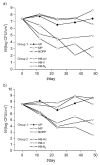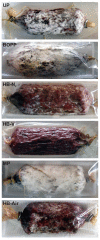Microbiological and Sensory Characteristics of Mould-Ripened Salami under Different Packaging Conditions
- PMID: 31316280
- PMCID: PMC6600306
- DOI: 10.17113/ftb.57.01.19.5803
Microbiological and Sensory Characteristics of Mould-Ripened Salami under Different Packaging Conditions
Abstract
The preservation of mould-ripened salami was investigated during 48 days at 19-20 °C under different packaging conditions: (i) high barrier film filled with air, 100% N2 or under vacuum, (ii) biaxially oriented polypropylene film, (iii) microperforated polyethylene film and (iv) unpackaged. Sensory, texture profile, physicochemical and microbiological analyses were performed. Fungal quantification revealed two data groups. In group 1 (consisting of salami in microperforated polyethylene film, biaxially oriented polypropylene film and unpackaged) the conidium viability was relatively constant. In group 2 (salami preserved in high barrier film filled with air, 100% N2 or under vacuum) the conidium viability decreased due to the absence of oxygen and the high carbon dioxide volume fraction. SEM micrographs showed micromorphological changes in fungal structure; microperforated polyethylene film, biaxially oriented polypropylene film and unpackaged conditions preserved the conidial morphology, while high barrier film filled with air, 100% N2 or vacuum conditions collapsed the hyphae and most of the conidia. Salami packed in microperforated polyethylene film and biaxially oriented polypropylene film showed the most acceptable organoleptic characteristics and lower hardness and chewiness values after packaging.
Keywords: Penicillium nalgiovense; dry sausages; mould-ripened salami; packaging.
Figures




References
-
- Leistner L. Mould-fermented foods: recent development. Food Biotechnol. 1990;4(1):433–41. 10.1080/08905439009549755 - DOI
-
- Mižáková A, Pipová M, Turek P. The occurrence of moulds in fermented raw meat products. Czech J Food Sci. 2002;20(3):89–94. 10.17221/3516-CJFS - DOI
-
- Ludemann V, Pose GN, Pollio ML, Segura J. Surface mycoflora of Argentinean dry fermented sausages and toxigenicity of Penicillium isolates. J Food Technol. 2004;2(4):288–92.
LinkOut - more resources
Full Text Sources
